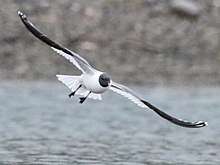Sabine's gull
Sabine's gull [2] (Xema sabini), also known as the fork-tailed gull or xeme, is a small gull. Its generic placement is disputed; some authors treat it as the sole species in the genus Xema as Xema sabini,[3] while others retain it in the genus Larus as Larus sabini.[4][5]
| Sabine's gull | |
|---|---|
.jpg) | |
| Adult in Iceland | |
| Scientific classification | |
| Kingdom: | Animalia |
| Phylum: | Chordata |
| Class: | Aves |
| Order: | Charadriiformes |
| Family: | Laridae |
| Genus: | Xema Leach, 1819 |
| Species: | X. sabini |
| Binomial name | |
| Xema sabini | |
 | |
The Sabine's gull breeds in colonies on coasts and tundra, laying two or three spotted olive-brown eggs in a ground nest lined with grass. It is very pelagic outside the breeding season. It takes a wide variety of mainly animal food, and will eat any suitable small prey. It also steals eggs from nesting colonies of Arctic terns.[3]
Description
.jpg)

The Sabine's gull is a small gull, 27 to 33 cm (11–13 in) in length and weighing 135 to 225 g (4.8–7.9 oz). The wings are long, thin and pointed with a span of between 81 to 87 cm (32–34 in). The bill, which is black with a yellow tip, is around 2.5 cm (0.98 in) long.
This species is easy to identify through its striking wing pattern. The adult has a pale grey back and wing coverts, black primary flight feathers and white secondaries. The white tail is forked. The male's hood darkens during breeding season. Young birds have a similar tricoloured wing pattern, but the grey is replaced by brown, and the tail has a black terminal band. Juveniles take two years to attain full adult plumage. Sabine's gulls have an unusual molt pattern for gulls. Fledged birds retain their juvenile plumage through the autumn and do not start molting into their first winter plumage until they have reached their wintering grounds. Adults have their complete molt in the spring prior to the spring migration, and have a partial molt in the autumn after returning to the wintering area, a reversal of the usual pattern for gulls.[6] They have a very high-pitched and squeaking call.[4]
Taxonomy and evolution
The Sabine's gull is usually treated as comprising a monotypic genus; it is only placed within the genus Larus when the genus is enlarged. The black bill and notched tail are almost unique within the gulls, as they are shared only with the swallow-tailed gull of the Galapagos. On the basis of this the two species were often thought to be each other's closest relatives, a hypothesis ruled out by a number of behaviour and ecological differences. Mitochondrial DNA studies confirmed that they are not closely related, and the closest relative of the Sabine's gull is now thought to be the ivory gull, another Arctic species. The two species are thought to have separated around 2 million years ago, longer ago than most groups of gull species.[7]
Geographical variation is slight; birds from Alaska are slightly darker and perhaps bigger. Most authorities recognise no races, but a few recognise four based on size and mantle (back) colour.[7] The Handbook of the Birds of the World recognises four subspecies. The nominate subspecies, X. s. sabini, breeds from the Canadian Arctic to Greenland. X. s. palaearctica (Stegman, 1934) breeds from Spitsbergen to the Taymyr Peninsula in Russia, and X. s. tschuktschorum (Portenko, 1939) breeds on the Chukotskiy Peninsula of Russia, and X. s. woznesenskii (Portenko, 1939) is found from the Gulf of Anadyr to Alaska.[8]
The specific epithet and common name honour the Irish scientist Sir Edward Sabine, who sent a specimen to his brother Joseph Sabine; Joseph referred to it as Larus sabini in 1818.[9] (The first accepted description was by Leach in 1819.) The Oxford English Dictionary gives the pronunciation /ˈsæbaɪn/ SAB-eyen,[9] which is the pronunciation of the surname according to a history of the Sabine family.[10] However, some authorities give /ˈsæbɪn/ SAB-in.[11] The genus name Xema appears to be an invented name without meaning.[12]
Distribution and habitat
It breeds in the Arctic and has a circumpolar distribution through northernmost North America and Eurasia. It migrates south in autumn; most of the population winters at sea in the Pacific off western South America in the cold waters of the Humboldt Current, while Greenland and eastern Canadian birds cross the Atlantic by way of the westernmost fringes of Europe to winter off southwest Africa in the cold waters of the Benguela Current. Occasionally individual Sabine's gulls can be seen off other coasts such as the northeastern United States or further east in Europe, typically following autumn storms.[3][13] It is recorded often enough inland in North America, Europe, and even Siberia, that it has been said to exhibit "cross-continental migration" in addition to migration at sea.[7]
Diet and feeding
The diet and feeding technique of the Sabine's gull varies by season and habitat. In the breeding season it takes a range of freshwater and terrestrial prey on the tundra. This includes insects and probably spiders, aquatic insects and insect larvae, crustaceans, fish and young birds and eggs. Young birds and eggs are taken opportunistically and rarely, but can include black turnstones, lapland longspurs and even the eggs of other Sabine's gulls and geese. Insects and insect larvae taken include terrestrial and aquatic beetles, springtails, craneflies, mosquitos, midges, and flower flies (Syrphidae).[7]
References
- Butchart, S.; Symes, A. (2015). "Xema sabini". IUCN Red List of Threatened Species. 2015: e.T22694479A85116152.
- Sabine is pronounced either /ˈsæbaɪn/ SAB-eyen or /ˈseɪbaɪn/ SAY-byne. See below.
- del Hoyo, J.; Elliot, A.; Sargatal, J., eds. (1998). Handbook of the Birds of the World. 3. Barcelona: Lynx Edicions. p. 621. ISBN 84-87334-20-2.
- Snow, D.W.; Perrins, C.M., eds. (1998). The Birds of the Western Palearctic (Concise ed.). ISBN 978-0198540991.
- Hagemeijer, W.J.M.; Blair, M.J., eds. (1997). The EBCC Atlas of European Breeding Birds. London: Poyser. ISBN 0-85661-091-7.
- Montevecchi, W; Stenhouse, I; Gilchrist, H (2001). "Reproductive Biology of Sabine's Gull in the Canadian Arctic" (PDF). The Auk. 103 (1): 98–107. doi:10.1650/0010-5422(2001)103[0098:RBOSSG]2.0.CO;2.
- Day, Robert H.; Stenhouse, Ian J.; Gilchrist, H. Grant (2001). "Sabine's Gull (Xema sabini)". The Birds of North America Online. Ithaca: Cornell Lab of Ornithology. doi:10.2173/bna.593. Retrieved 6 January 2011.
- Burger, J., Gochfeld, M. & Garcia, E.F.J. (2017). Sabine’s Gull (Xema sabini). In: del Hoyo, J., Elliott, A., Sargatal, J., Christie, D.A. & de Juana, E. (eds.). Handbook of the Birds of the World Alive. Lynx Edicions, Barcelona. (retrieved from http://www.hbw.com/node/54008 on 1 April 2017).
- "Sabine, n.2". OED Online. Oxford University Press. September 2013. Retrieved 9 November 2013.
- Sabine, William Henry Waldo (1953). Sabin(e): The History of an Ancient English Surname. Privately reproduced. p. 84. Quoted by Wright, Rick (28 Oct 2013). "How Do You Say...?". Birding New Jersey. Retrieved 9 November 2013.
- Terres, John K. (1980). Audubon Society Encyclopedia of North American Birds. Knopf. ISBN 0-394-46651-9. Also Webster's Third New International Dictionary (1961). According to McGowan, Kevin J. "Bird Name Pronunciations". Retrieved 9 November 2013.
- Jobling, James A (2010). The Helm Dictionary of Scientific Bird Names. London: Christopher Helm. p. 410. ISBN 978-1-4081-2501-4.
- Bull, John; Farrand, Jr., John (April 1984). The Audubon Society Field Guide to North American Birds, Eastern Region. New York: Alfred A. Knopf. ISBN 0-394-41405-5.
External links
| Wikimedia Commons has media related to Xema sabini. |
| Wikispecies has information related to Xema sabini |
- BirdLife species factsheet for Xema sabini
- "Xema sabini". Avibase.

- "Sabine's gull media". Internet Bird Collection.
- Sabine's gull photo gallery at VIREO (Drexel University)
- Interactive range map of Xema sabini at IUCN Red List maps
- Audio recordings of Sabine's gull on Xeno-canto.
- Xema sabini in the Flickr: Field Guide Birds of the World
- Sabine's gull media from ARKive

